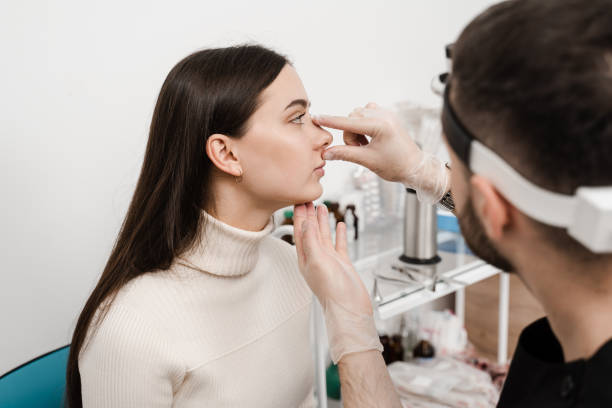Rhinoplasty, often referred to as a "nose job," is a surgical procedure designed to enhance the appearance and functionality of the nose. This popular cosmetic surgery can transform not only the aesthetics of the face but also improve breathing issues. Whether you're considering Rhinoplasty in Dubai for cosmetic reasons or to address medical concerns, understanding the procedure is crucial to making informed decisions.
Understanding Rhinoplasty
Rhinoplasty is a versatile surgical procedure that can address a range of concerns. Common motivations for undergoing rhinoplasty include correcting the nose's size, shape, or profile. Many people seek to improve the appearance of a large, crooked, or bulbous nose. Others may want to repair damage from an injury or enhance their facial symmetry.
The procedure can also address functional issues, such as correcting a deviated septum, which can impede proper airflow and cause breathing difficulties. In these cases, rhinoplasty not only beautifies the nose but also improves overall nasal function.
The Rhinoplasty Consultation
Before undergoing rhinoplasty, a thorough consultation with a qualified surgeon is essential. During this initial meeting, the surgeon will discuss your goals, evaluate your nasal structure, and review your medical history. This is an excellent opportunity to ask questions and express any concerns.
Be prepared to discuss your motivations for the surgery and your expectations for the outcome. The surgeon may take photographs and create a simulation of the potential results to help you visualize the changes. Open communication during this process is vital to ensure that both you and the surgeon are aligned on the desired outcome.
The Surgical Procedure
Rhinoplasty is typically performed under general anesthesia or local anesthesia with sedation, depending on the complexity of the procedure and your surgeon's recommendation. The surgical technique can vary based on the desired outcomes and the surgeon’s preferences.
There are two primary techniques in rhinoplasty: open and closed. In open rhinoplasty, a small incision is made across the columella (the tissue between the nostrils), allowing the surgeon greater visibility and access to the nasal structures. Closed rhinoplasty involves incisions made inside the nostrils, resulting in no visible scarring. Your surgeon will determine which method is best suited for your individual needs.
Recovery Process
Following rhinoplasty, recovery is an essential aspect of the process. Initially, it’s common to experience swelling, bruising, and mild discomfort. Your surgeon will provide postoperative instructions that may include the use of ice packs to minimize swelling and prescribed medications to manage pain.
Typically, the majority of swelling subsides within the first two weeks, though some residual swelling may persist for months. During this recovery period, it’s important to avoid strenuous activities and follow your surgeon’s recommendations closely. Attending follow-up appointments will allow your surgeon to monitor your healing progress and address any concerns.
Expected Results and Realistic Goals
One of the most critical aspects of rhinoplasty is understanding what to expect from the results. Every nose is unique, and individual healing processes can vary significantly. The final results of rhinoplasty may take several months to fully manifest as swelling gradually subsides.
Setting realistic goals is crucial. While many individuals experience a boost in self-esteem and satisfaction following rhinoplasty, it’s essential to remember that no surgical procedure can create a perfect nose. Instead, the aim should be to achieve an outcome that enhances your features and brings harmony to your facial profile.
Potential Risks and Considerations
As with any surgical procedure, rhinoplasty carries inherent risks. Complications can include infection, adverse reactions to anesthesia, and dissatisfaction with aesthetic results. Additionally, some patients may experience breathing difficulties post-surgery, though these issues can often be addressed with further intervention.
Before proceeding, it’s vital to discuss potential risks with your surgeon. They can help you weigh the benefits against possible complications, empowering you to make an informed decision.
Choosing the Right Surgeon
Selecting a qualified, experienced surgeon is one of the most critical steps in the rhinoplasty process. Research their credentials, experience, and patient reviews. Look for a surgeon who specializes in facial procedures and has a solid track record of successful rhinoplasty surgeries.
A good surgeon will not only have the technical skills needed for the procedure but will also take the time to understand your aesthetic goals, ensuring that you are fully informed about your options.
The Emotional Impact of Rhinoplasty
Undergoing rhinoplasty is not solely a physical transformation; it can also have significant emotional and psychological benefits. Many patients report increased confidence and improved self-image following the procedure. However, it’s important to recognize that individual experiences may vary.
Engaging in open conversations with friends, family, or a mental health professional can help you navigate any emotional challenges that may arise. It's essential to acknowledge both the benefits and the potential emotional impact of such a significant change.
Conclusion
Rhinoplasty offers a unique opportunity to reshape and redefine your facial features, whether for aesthetic or functional purposes. By thoroughly understanding the procedure, from initial consultation to recovery, you can approach your journey with confidence. Educating yourself will empower you to make informed decisions and work towards achieving the results you desire. Always remember that the key to a successful rhinoplasty lies in careful planning and choosing the right surgical partner.





Comments